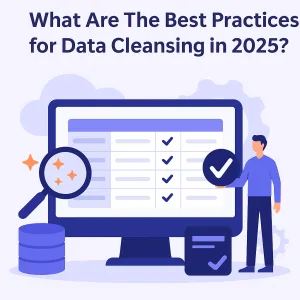What Are The Best Practices for Data Cleansing in 2025?

In 2025, data cleansing isn’t just about fixing typos or deleting blank rows from a spreadsheet. It’s a critical part of every modern data strategy—one that now includes not just cleaning errors, but also standardizing formats, validating entries, deduplicating records, merging data, and performing name matching and fuzzy matching at scale.
Whether you’re a business leader trying to unify customer records or a data professional building pipelines that feed analytics and AI models, data cleansing is no longer optional. It’s foundational.
Let’s look at what data cleansing really means in 2025—and why it matters more than ever.
Data Cleansing Has Evolved
Traditional data cleansing meant fixing inconsistencies, deleting bad data, and making sure fields were filled in correctly. In 2025, it’s much more comprehensive.
Today, cleansing includes:
Error removal: Detecting and fixing typos, invalid characters, and corrupted values
Normalization: Bringing different formats into a common structure (e.g., phone numbers, casing, date formats)
Standardization: Converting fields to defined, repeatable formats (e.g., “St.” to “Street”)
Validation: Ensuring fields like emails, zip codes, and phone numbers match real-world patterns or reference data
Name matching and fuzzy matching: Identifying similar but not identical records
Deduplication and merging: Removing repeated records and combining relevant values into a single, complete record
It’s no longer enough to fix what’s broken—you have to shape your data to be trusted, usable, and aligned across systems.
Why Data Cleansing Is a Business Priority
Businesses are using more tools than ever: CRMs, ERPs, analytics platforms, marketing systems, spreadsheets, and more. Each one introduces slight inconsistencies in how data is stored, labeled, or entered. That means more room for error, duplication, and conflict.
Clean data impacts:
Marketing segmentation and campaign success
Customer experience and personalization
Analytics accuracy and forecasting
Regulatory compliance
Operational efficiency
Dirty data, on the other hand, causes missed opportunities, wasted spend, and erosion of trust.
This is why modern data cleansing is integrated into every smart data stack—and why more companies are turning to tools like Match Data Pro to handle it at scale.
Fuzzy Matching and Name Matching: Core to Data Cleansing
One of the biggest shifts in 2025 is the recognition that perfect data doesn’t exist. You can’t rely only on exact matches when names, emails, and addresses vary slightly across systems.
That’s where fuzzy matching and name matching come in.
Name matching helps you link “Jon Smith” to “Jonathan Smyth.”
Fuzzy matching lets you match “Acme Ltd.” to “ACME Limited” even when punctuation, casing, or typos exist.
These methods are no longer “nice to have.” They’re expected.
Match Data Pro lets you define fuzzy matching logic across fields like name, email, phone, address, and more—so you can trust your matches without sacrificing accuracy.
Entity Resolution and Deduplication
In today’s data environment, the same person or organization often appears in multiple systems—with slightly different details. This creates fragmentation and noise.
Modern data cleansing includes a process known as entity resolution:
Identify records that refer to the same entity (person, company, location)
Merge them into a single, accurate record (aka the “golden record”)
Remove or archive duplicates
This isn’t just about saving storage space—it’s about ensuring your sales team sees the right account, your support team contacts the right customer, and your reports reflect reality.
Why Data Profiling Comes First
You can’t fix what you don’t understand.
Before you cleanse or match anything, you need data profiling. This process scans your dataset and shows:
Which columns are mostly empty or duplicated
What patterns exist (e.g., phone number formats)
How many records are unique, inconsistent, or problematic
At Match Data Pro, we include a full data profiling engine so you can see exactly what you’re working with before you take action. Profiling helps guide your cleansing strategy so you can prioritize what matters.
Automation Is the Future of Cleansing
In 2025, no one should be cleaning data manually. Instead:
Cleansing rules should be reusable and editable
Matching logic should be configurable per project
Pipelines should be scheduled or triggered automatically
That’s why Match Data Pro lets you:
Create data cleansing projects through an intuitive interface
Reuse those projects across multiple data sources
Run them on-demand, via schedule, or through API automation
The result? Clean, matched, validated data—without repetitive work.
What Sets Modern Data Cleansing Apart
Let’s recap what makes 2025-style data cleansing different:
It includes advanced techniques like fuzzy matching, name matching, and entity resolution
It starts with data profiling to uncover structure, errors, and trends
It emphasizes reusability—you don’t clean the same way twice
It’s deeply integrated with data matching and deduplication
It’s automated—not just manual cleanup in spreadsheets
This shift reflects a broader reality: clean data isn’t a project. It’s a process. And it requires the right tools to do it right.
Get Ahead With Modern Data Cleansing
Clean data drives everything: marketing, reporting, decision-making, and customer satisfaction. If your organization is still relying on manual cleanup or disconnected tools, it’s time to modernize.
With Match Data Pro, you get everything you need:
Advanced data cleansing tools
Configurable name matching and fuzzy matching logic
Powerful data matching and entity resolution features
Visual data profiling to guide your cleanup
Automation options for maximum efficiency
Start your data cleansing project today and unlock cleaner, more trustworthy data—faster than ever before.
Ready to see what modern cleansing looks like? Register now to get started.
